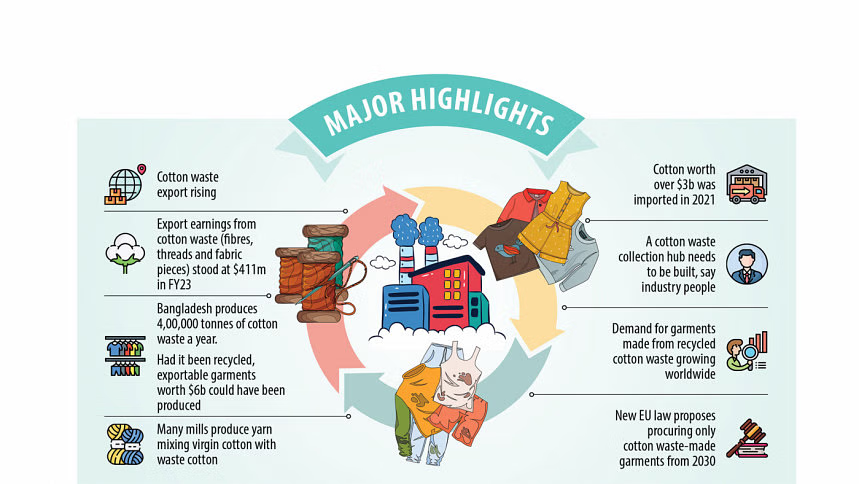Cotton Waste The New Cash Cow
Cotton waste the new cash cow
But garment makers for reusing it thru recycling within the country

Cotton waste is turning into a new cash cow for Bangladesh as it is increasingly being sold abroad although local garment exporters are in favour of retaining and recycling it.
Cotton waste refers to textile waste generated in the spinning, weaving and textile industry, coming in formats such as fibres, threads or fabric pieces depending on the stage of the transformation process.
Cotton waste exports marked a significant rise of 76.77 percent year-on-year to fetch $84.85 million in the July-August period, the first two months of the current fiscal year, as per the Export Promotion Bureau.
Last fiscal year, Bangladesh exported $411.12 million worth of cotton waste. Even a few years ago, it was less than $100 million.
Demand for cotton waste is rising worldwide with increased awareness among end consumers on the sustainable use of garments through recycling.
With consumers in the West shifting to fast fashion, local garment suppliers are also modifying their production to make use of more sustainable raw materials such as cotton waste.
Bangladesh generates around 4,00,000 tonnes of cotton waste a year. If recycled, it could be used to manufacture exportable garments worth $6 billion. However, most of the cotton waste is being exported for its high price, driven by a higher demand.
Recently, Swedish retail giant H&M asked garment suppliers to use more cotton waste than raw cotton in manufacturing processes. Clothing retailers and brands prefer the reuse and recycling of garments to avoid environmental damage.
Moreover, owing to a new proposed European Union law, consumption of garments made from cotton waste will rise in the bloc.
The EU will not buy garments from factories which do not use cotton waste from 2030.
The move is a push towards what is popularly known as circular fashion.
Circular fashion is a closed-loop system making new materials out of old materials, reducing the number of natural resources used to make clothing and diverting products from landfills.
Annually $400 million worth of cotton waste is exported from Bangladesh, which local garment exporters are very much against, said Md Shahidullah Azim, vice president of the Bangladesh Garment Manufacturers and Exporters Association (BGMEA).
The BGMEA has already urged the government to ban the export of cotton waste so that such raw materials are readily available in the domestic market for local garment manufacturers.
"This is because more use of cotton waste means more value-addition and more employment as the demand for garments made from cotton waste is rapidly increasing worldwide," Azim said.
A cotton waste collection hub needs to be built so that there is no waste of valuable materials, he said, urging the government to waive the VAT on the sale of cotton waste in the country.
Bhaluka-d Simco Spinning & Textiles Ltd is currently producing 20 tonnes of recycled yarn a day, said its executive director Md Abdur Rouf.
The mill is facing a shortage of raw materials as a section of traders are exporting them to avail better prices, said Rouf.
"The shortage will further be compounded if mills expand their production capacity to meet demand," he said, adding that the prices of the raw materials are high in the local markets as demand is also high.
Many local factories have already started producing garments from cotton waste, said Vidiya Amrit Khan, director in charge of the standing committee of the Circular Fashion Partnership project at the BGMEA.
Over the past decade, local garment suppliers were mainly busy enhancing compliance to regulations at the factory level, she said.
"But in recent times they have been focusing more on circular fashion and setting up new technologies. So, it is expected that more garment factories will start making use of cotton waste and grabbing a bigger share of the global market."
Spinners are not getting adequate amounts of cotton waste as the generation of cotton waste has been low over the last couple of years, said Mohammad Ali Khokon, president of the Bangladesh Textile Mills Association.
But production of yarn from cotton waste is growing gradually with the increased usage of the recycled material worldwide, he said.
Many local mills are producing yarn mixing virgin cotton with cotton waste. But the low production of yarn from cotton waste means the country is missing out on the opportunity to manufacture apparel out of recycled materials in tune with skyrocketing demand globally.
In 2019, Bangladesh's garment factories and fabric mills produced approximately 577,000 tonnes of cotton waste, according to the Circular Fashion Partnership project led by Global Fashion Agenda, in partnership with Reverse Resources and the BGMEA.
Of the volume, almost half was 100 per cent pure cotton. If it was recycled within Bangladesh, cotton imports could have decreased by around 15 per cent, therefore saving $500 million, as per the project.
Bangladesh heavily relies on the import of textile fibre. Around 1.63 million tonnes of cotton were imported in 2019 whose value was estimated to be $3.5 billion.


